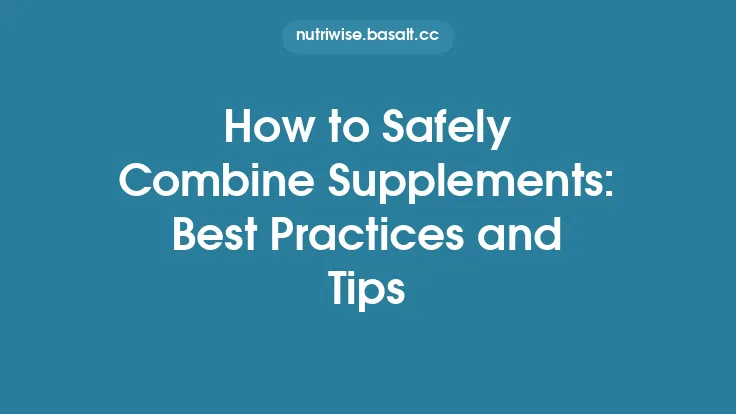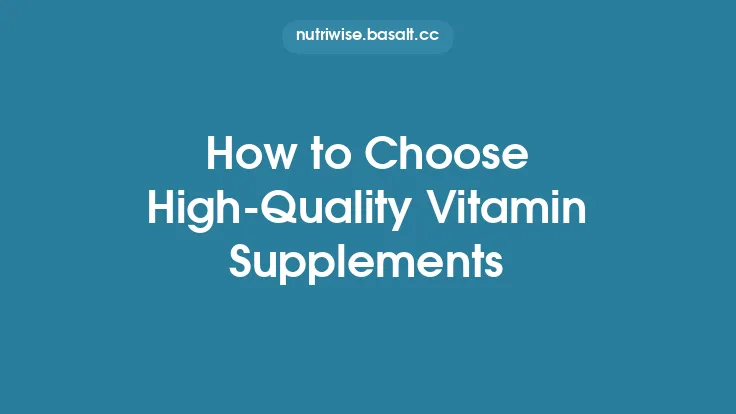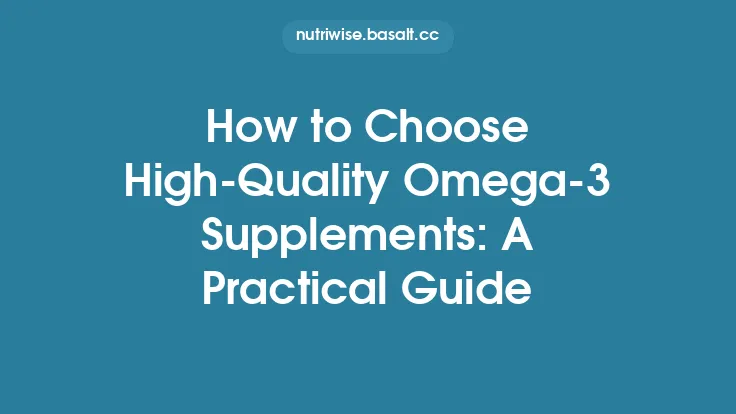Supplements promise health benefits, but the reality can be compromised when unwanted substances slip into the product. Contaminants—unintended chemicals, microbes, or heavy metals—and adulterants—deliberately added substances that are not listed on the label—pose serious risks to consumers. Knowing how to spot these hidden hazards empowers you to make safer choices and protect your well‑being.
Common Types of Contaminants in Dietary Supplements
| Contaminant Category | Typical Sources | Health Concerns | Why It Appears in Supplements |
|---|---|---|---|
| Heavy Metals (lead, arsenic, cadmium, mercury) | Soil and water where raw botanicals are grown; processing equipment | Neurotoxicity, kidney damage, carcinogenicity | Plants absorb metals from contaminated soils; metal‑containing machinery can leach into powders |
| Microbial Contaminants (Salmonella, E. coli, mold, mycotoxins) | Poor sanitation during harvest, drying, or encapsulation | Gastrointestinal illness, immune suppression, liver toxicity (mycotoxins) | Inadequate drying, humid storage, or contaminated water used in processing |
| Pesticide Residues (organophosphates, carbamates) | Agricultural sprays on herbs and botanicals | Neurological effects, endocrine disruption | Insufficient washing or failure to source organically grown material |
| Plasticizers & Solvents (phthalates, bisphenol A, residual ethanol) | Packaging materials, extraction solvents | Hormone disruption, reproductive toxicity | Leaching from plastic containers or incomplete solvent removal |
| Allergenic Proteins (gluten, soy, dairy) | Cross‑contamination in shared facilities | Allergic reactions, anaphylaxis | Shared equipment without proper cleaning between batches |
| Undeclared Additives (artificial colors, sweeteners) | Cost‑cutting measures, flavor enhancement | Allergic reactions, metabolic effects | Intentional addition without label disclosure |
Understanding the origin of each contaminant helps you evaluate the plausibility of its presence in a given product. For instance, a marine‑derived omega‑3 supplement is more likely to contain heavy metals than a synthetic vitamin D tablet.
Understanding Adulterants: When Supplements Are Not What They Claim
Adulterants differ from contaminants in that they are intentionally added to boost perceived efficacy or mimic the effects of prescription drugs. Common adulterants include:
| Adulterant Class | Representative Substances | Intended Effect | Typical Red Flags |
|---|---|---|---|
| Pharmaceutical Stimulants | DMAA, synephrine, phenethylamine analogs | Energy, weight loss | Claims of “extreme energy” or “rapid fat burn” without scientific backing |
| Anabolic Agents | Steroid precursors (e.g., 1‑testosterone), SARMs | Muscle growth | “Pro‑muscle” or “enhanced recovery” language, especially in bodybuilding formulas |
| Prescription‑grade Hormones | Thyroid hormone (T3/T4), melatonin in high doses | Metabolism regulation | Doses far exceeding typical dietary supplement levels |
| Synthetic Cannabinoids | JWH‑018, HU‑210 | Relaxation, pain relief | “Herbal blend” marketed for “stress relief” with no cannabis‑derived ingredients |
| Undeclared Pharmaceuticals | Sildenafil, tadalafil | Sexual performance | “Performance enhancer” claims without mentioning active drug |
Adulterants are often hidden because they are illegal in dietary supplements. Their presence is usually uncovered only through sophisticated laboratory testing.
Laboratory Techniques for Detecting Contaminants
While most consumers cannot run a lab, understanding the analytical methods used by professionals clarifies why certain test results are reliable.
- Inductively Coupled Plasma Mass Spectrometry (ICP‑MS)
- Purpose: Quantifies trace heavy metals down to parts‑per‑billion (ppb).
- Strengths: Extremely sensitive, can differentiate isotopes (e.g., lead‑206 vs. lead‑207).
- Limitations: Requires digestion of the sample; not suitable for organic contaminants.
- High‑Performance Liquid Chromatography (HPLC) with UV/Vis or Mass Spectrometric Detection
- Purpose: Separates and identifies organic compounds such as pesticides, plasticizers, and adulterants.
- Strengths: Can detect multiple compounds in a single run; mass spectrometry adds structural confirmation.
- Limitations: Complex matrixes (e.g., protein‑rich powders) may need extensive sample preparation.
- Gas Chromatography–Mass Spectrometry (GC‑MS)
- Purpose: Ideal for volatile and semi‑volatile contaminants like residual solvents and certain pesticides.
- Strengths: High resolution for isomeric compounds; widely accepted for solvent residue testing.
- Limitations: Non‑volatile substances require derivatization.
- Polymerase Chain Reaction (PCR)–Based Microbial Assays
- Purpose: Detects DNA from pathogenic bacteria and fungi, even when viable cells are low.
- Strengths: Rapid (hours vs. days for culture); highly specific.
- Limitations: Cannot differentiate between live and dead organisms without additional steps.
- Enzyme‑Linked Immunosorbent Assay (ELISA)
- Purpose: Screens for specific mycotoxins (e.g., aflatoxin B1) and allergens.
- Strengths: Cost‑effective for high‑throughput screening.
- Limitations: Potential cross‑reactivity; less quantitative than LC‑MS.
- Fourier‑Transform Infrared Spectroscopy (FT‑IR) and Near‑Infrared (NIR) Spectroscopy
- Purpose: Provides a “fingerprint” of the overall chemical composition; useful for detecting gross adulteration.
- Strengths: Non‑destructive, rapid.
- Limitations: Lower sensitivity; best used as a preliminary screening tool.
When a supplement’s safety report cites any of these methods, it indicates a robust analytical approach. The presence of multiple complementary techniques (e.g., ICP‑MS for metals *and* HPLC‑MS for organic contaminants) is a strong indicator of thorough testing.
Red Flags in Product Information and Marketing
Even without a lab report, certain marketing cues can hint at a higher likelihood of contamination or adulteration:
- Exaggerated Performance Claims – Phrases like “clinically proven to double muscle mass in 30 days” often accompany undisclosed stimulants or anabolic agents.
- Vague Ingredient Lists – Terms such as “proprietary blend” that hide exact quantities make it impossible to assess safety margins.
- Absence of a Batch or Lot Number – Legitimate manufacturers track each production run; missing numbers impede traceability.
- Unusual Pricing – Extremely low prices for premium‑grade botanicals may indicate substandard sourcing or dilution with fillers.
- Lack of Transparency About Sourcing – No mention of country of origin, farm, or harvest method can mask contaminated raw material.
- Overly Complex Formulations – Products that combine dozens of herbs, amino acids, and “exotic extracts” increase the risk of cross‑contamination.
When you encounter any of these signals, treat the product with heightened scrutiny.
How to Verify Independent Testing Results
Many brands publish a “Certificate of Analysis” (CoA) on their website. To assess its credibility:
- Check the Laboratory Identity – Look for an accredited, independent lab (e.g., ISO‑17025 certified).
- Confirm the Test Scope – A reliable CoA lists *all* contaminants tested, not just the ones that passed.
- Examine Detection Limits – Values should be reported with units (µg/kg, ppm) and the method’s limit of detection (LOD).
- Match the Batch Number – The CoA must reference the exact lot you purchased; a generic CoA is less trustworthy.
- Look for Full Data Tables – Partial results (e.g., “heavy metals: below detection”) without numbers can be ambiguous.
- Cross‑Reference Multiple Sources – If the brand provides a CoA, see if third‑party databases (e.g., ConsumerLab, Labdoor) have independent analyses of the same product.
A transparent CoA that meets these criteria is a strong indicator that the manufacturer has taken contaminant testing seriously.
Practical Steps Consumers Can Take
| Action | How to Implement | Why It Helps |
|---|---|---|
| Read the Full Ingredient List | Scroll past the “Supplement Facts” to see any “other ingredients.” | Detects hidden fillers or allergens that could be contamination sources. |
| Verify the Batch/Lot Number | Locate the number on the bottle and compare it to the CoA (if available). | Ensures the test results correspond to your specific product. |
| Research the Manufacturer’s Reputation | Search for news articles, scientific reviews, or consumer complaints. | Companies with a history of recalls are more likely to have quality lapses. |
| Check for Independent Reviews | Use reputable supplement review sites that publish lab data. | Third‑party testing adds an extra layer of verification. |
| Avoid “Proprietary Blend” Labels When Possible | Choose products that disclose exact amounts of each ingredient. | Transparency reduces the chance of undisclosed contaminants. |
| Store Supplements Properly | Keep in a cool, dry place; avoid exposure to sunlight. | Prevents microbial growth and degradation that can create harmful by‑products. |
| Limit Use of High‑Risk Categories | Be cautious with weight‑loss, pre‑workout, and “herbal stimulant” products. | These categories have higher incidences of adulteration. |
| Consult a Healthcare Professional | Bring the supplement bottle to a pharmacist or physician for advice. | Professionals can spot red flags you might miss and advise on safe alternatives. |
When to Seek Professional Advice
- Unexplained Symptoms – If you develop headaches, gastrointestinal distress, or allergic reactions after starting a new supplement, stop use immediately and consult a clinician.
- Pregnancy or Chronic Illness – Certain contaminants (e.g., heavy metals) can be especially harmful; a healthcare provider can help assess risk.
- Concurrent Medications – Some adulterants (e.g., stimulants) may interact dangerously with prescription drugs.
- Suspected Contamination – If you suspect a product is contaminated, a pharmacist can guide you on reporting the issue to consumer safety agencies.
Future Trends in Contaminant Detection
The supplement industry is gradually adopting newer technologies that may soon become standard for consumer safety:
- Portable Mass Spectrometry – Handheld devices capable of on‑site screening for heavy metals and pesticides could allow retailers to test batches before shelving.
- Blockchain‑Based Traceability – Immutable records of raw‑material sourcing and testing results can enhance transparency for end‑users.
- Artificial Intelligence (AI) in Spectral Analysis – Machine‑learning algorithms can rapidly interpret FT‑IR or NIR spectra to flag anomalies that human analysts might miss.
- DNA Barcoding of Botanical Ingredients – Sequencing short DNA fragments verifies the botanical species present, reducing the risk of misidentified or contaminated plant material.
Staying aware of these emerging tools can help you anticipate higher standards of safety in the years ahead.
By understanding the types of contaminants and adulterants that can infiltrate dietary supplements, recognizing the analytical methods used to uncover them, and applying a disciplined, evidence‑based approach to product selection, you can dramatically reduce the risk of exposure to hidden hazards. The effort may require a bit of extra research, but the payoff—peace of mind and genuine health support—is well worth it.





